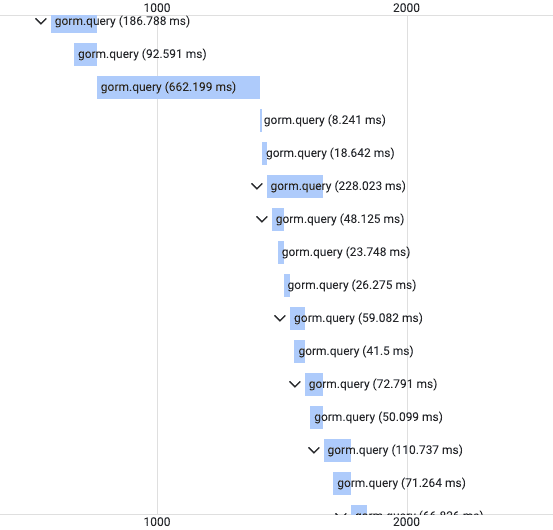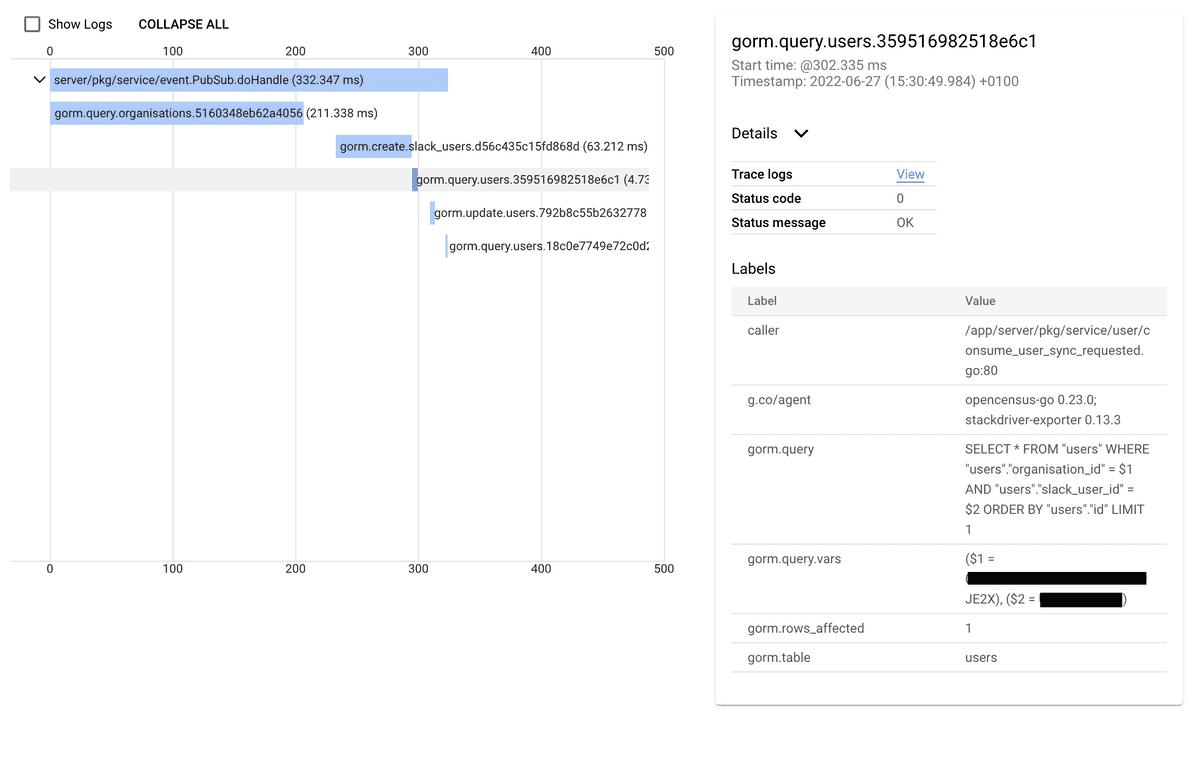Gorm作为Go语言中很常用的一个ORM库,功能非常强大。应用程序的大量时间都花在通过gorm与数据库连接上面,所以我们想在链路跟踪中获得更好的视图。
幸运的是,Gorm有完美的钩子,我们可以通过Callbacks API将跟踪功能注入到数据库处理当中。Callbacks API允许我们为Gorm提供在查询生命周期的特定部分中执行相应的函数,或者允许您在传统的中间件方法中更改查询行为,或者在我们的例子中,为可观察性提取数据。
func beforeQuery(scope *gorm.DB) {
// do stuff!
}
db.Callback().
Create().
Before("gorm:query").
Register("instrumentation:before_query", beforeQuery)这篇文章的目标是在我们的Gorm查询中引入链路跟踪,为了做到这一点,我们需要同时捕获开始和结束事件,并相应地处理链路信息span。在这些例子中,我将使用go.opencensus.io/trace提供的跟踪工具,它对接谷歌云跟踪,但其他跟踪库的行为应该类似。
现在我们有一个函数在查询开始时调用,我们需要引入链路追逐:
func beforeQuery(scope *gorm.DB) {
db.Statement.Context = startTrace(
db.Statement.Context,
db,
operation,
)
}
func startTrace(
ctx context.Context,
db *gorm.DB,
) context.Context {
// 判断是否需要启动链路追逐,查看追踪的span是否存在
if span := trace.FromContext(ctx); span == nil {
return ctx
}
ctx, span := trace.StartSpan(ctx, "gorm.query")
return ctx
}然后我们需要对这个追踪span收尾处理:
func afterQuery(scope *gorm.DB) { endTrace(scope) }
func endTrace(db *gorm.DB) {
span := trace.FromContext(db.Statement.Context)
if span == nil || !span.IsRecordingEvents() {
return
}
var status trace.Status
if db.Error != nil {
err := db.Error
if err == gorm.ErrRecordNotFound {
status.Code = trace.StatusCodeNotFound
} else {
status.Code = trace.StatusCodeUnknown
}
status.Message = err.Error()
}
span.SetStatus(status)
span.End()
}
db.Callback().
Query().
After("gorm:query").
Register("instrumentation:after_query", afterQuery)现在我们可以在链路追踪中看到所有gorm查询!

然而,上图中不太清楚查询实际上在做什么,让我们看看是否可以让这些span包含更多有用信息,通过添加:
- 数据库表名信息和查询指纹
- 函数调用代码行数
- 查询的WHERE参数
- 影响表行数
查询指纹是查询的唯一标识符,与格式和变量无关,因此您可以唯一地标识在数据库中具有相同行为的查询。
让我们扩展前面的代码:
func startTrace(ctx context.Context, db *gorm.DB) context.Context {
// Don't trace queries if they don't have a parent span.
if span := trace.FromContext(ctx); span == nil {
return ctx
}
// start the span
ctx, span := trace.StartSpan(ctx, fmt.Sprintf("gorm.query.%s", db.Statement.Table))
// set the caller of the gorm query, so we know where in the codebase the
// query originated.
//
// walk up the call stack looking for the line of code that called us. but
// give up if it's more than 20 steps, and skip the first 5 as they're all
// gorm anyway
var (
file string
line int
)
for n := 5; n < 20; n++ {
_, file, line, _ = runtime.Caller(n)
if strings.Contains(file, "/gorm.io/") {
// skip any helper code and go further up the call stack
continue
}
break
}
span.AddAttributes(trace.StringAttribute("caller", fmt.Sprintf("%s:%v", file, line)))
// add the primary table to the span metadata
span.AddAttributes(trace.StringAttribute("gorm.table", db.Statement.Table))
return ctx
}
func endTrace(db *gorm.DB) {
// get the span from the context
span := trace.FromContext(db.Statement.Context)
if span == nil || !span.IsRecordingEvents() {
return
}
// set the span status, so we know if the query was successful
var status trace.Status
if db.Error != nil {
err := db.Error
if err == gorm.ErrRecordNotFound {
status.Code = trace.StatusCodeNotFound
} else {
status.Code = trace.StatusCodeUnknown
}
status.Message = err.Error()
}
span.SetStatus(status)
// add the number of affected rows & query string to the span metadata
span.AddAttributes(
trace.Int64Attribute("gorm.rows_affected", db.Statement.RowsAffected),
trace.StringAttribute("gorm.query", db.Statement.SQL.String()),
)
// Query fingerprint provided by github.com/pganalyze/pg_query_go
fingerprint, err := pg_query.Fingerprint(db.Statement.SQL.String())
if err != nil {
fingerprint = "unknown"
}
// Rename the span with the fingerprint, as the DB handle
// doesn't have SQL to fingerprint before being executed
span.SetName(fmt.Sprintf("gorm.query.%s.%s", db.Statement.Table, fingerprint))
// finally end the span
span.End()
}
func afterQuery(scope *gorm.DB) {
// now in afterQuery we can add query vars to the span metadata
// we do this in afterQuery rather than the trace functions so we
// can re-use the traces for non-select cases where we wouldn't want
// to record the vars as they may contain sensitive data
// first we extract the vars from the query & map them into a
// human readable format
fieldStrings := []string{}
if scope.Statement != nil {
fieldStrings = lo.Map(scope.Statement.Vars, func(v any i int) string {
return fmt.Sprintf("($%v = %v)", i+1, v)
})
}
// then add the vars to the span metadata
span := trace.FromContext(scope.Statement.Context)
if span != nil && span.IsRecordingEvents() {
span.AddAttributes(
trace.StringAttribute("gorm.query.vars", strings.Join(fieldStrings, ", ")),
)
}
endTrace(scope)
}现在,我们获得了非常简单详细的数据库查询跟踪信息,使我们更容易理解我们的应用程序在做什么!

Gorm为查询生命周期的不同部分提供回调,你可以为它们添加特定的行为,我们目前分别跟踪创建、删除、更新和查询,但如果你想更进一步,你可以查看Gorm文档!. 你可以在这里[https://gist.github.com/arussellsaw/bbedfdefee119b4600ce085b773da4b9]找到这篇文章中的所有代码。
请记住,如果不小心,您可能会追踪到一些敏感数据。因此,请确保清理您的查询变量。一个好的实践是只跟踪SELECT查询,因为它们通常是通过ID完成的,而不是任何敏感信息。